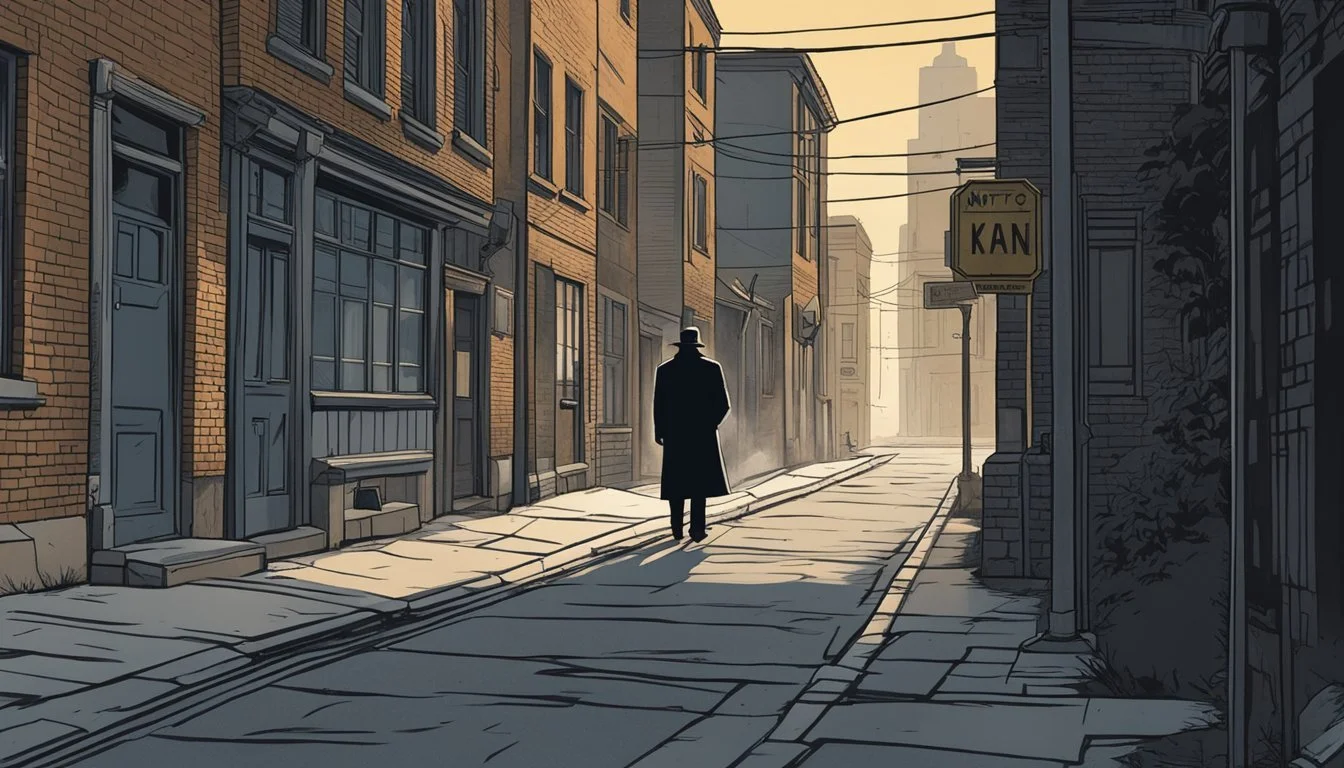Lorenzo Gilyard: 5 Eye-Opening Films on the Kansas City Strangler
Unmasking a Serial Killer's Legacy
Lorenzo Gilyard, known as the Kansas City Strangler, terrorized Missouri from 1977 to 1993. His crimes left a lasting impact on the community and sparked widespread fear. Gilyard was eventually convicted of multiple murders and sentenced to life in prison.
The case of Lorenzo Gilyard has captured public attention and been the subject of several films and documentaries. These productions offer viewers a deeper look into the investigation, trial, and aftermath of Gilyard's crimes. They explore the complexities of the case and provide insights into one of Missouri's most notorious serial killers.
1) The Kansas City Strangler: Unmasked
"The Kansas City Strangler: Unmasked" is a documentary film that explores the crimes of Lorenzo Gilyard. It delves into the investigation that led to his capture and conviction.
The film examines Gilyard's background and the circumstances surrounding his killing spree from 1977 to 1993. It features interviews with law enforcement officials involved in the case.
Forensic experts discuss the DNA evidence that ultimately linked Gilyard to 13 murders. The documentary also includes insights from family members of the victims.
Viewers gain an understanding of how Gilyard managed to evade capture for so long. The film highlights the advances in DNA technology that played a crucial role in solving these cold cases.
"The Kansas City Strangler: Unmasked" provides a comprehensive look at one of Missouri's most notorious serial killers. It offers a balanced perspective on the investigation and trial that brought Gilyard to justice.
2) Through the Eyes of the Strangler
"Serial Killer with Piers Morgan" offers a chilling glimpse into the mind of Lorenzo Gilyard. The documentary features an exclusive interview with the Kansas City Strangler himself, providing viewers with a rare opportunity to hear his perspective.
During the interview, Gilyard maintains his innocence despite the overwhelming evidence against him. His demeanor and responses offer insight into the psychology of a convicted serial killer.
The film explores Gilyard's background and the events leading up to his arrest. It delves into his life as a former trash company supervisor and examines how he managed to evade capture for so long.
Piers Morgan's probing questions and confrontational style add tension to the encounter. The documentary challenges viewers to consider the complexities of criminal psychology and the impact of Gilyard's crimes on the Kansas City community.
[Link to IMDb page for "Serial Killer with Piers Morgan"]
3) Finding Justice in Kansas City
"Serial Killer with Piers Morgan" featured Lorenzo Gilyard in a 2018 episode. The program explored the investigation and trial that led to Gilyard's conviction as the Kansas City Strangler.
During the interview, Gilyard maintained his innocence despite the evidence against him. This documentary provided insight into the complex case and the pursuit of justice for his victims.
The film showcased the efforts of Kansas City law enforcement to solve the string of murders that plagued the city for years. It highlighted the breakthroughs in DNA technology that ultimately linked Gilyard to the crimes.
Viewers gained a deeper understanding of the impact these murders had on the community and the relief felt when Gilyard was finally brought to justice. The documentary serves as a stark reminder of the long road to closure for the victims' families.
4) Hunting the Kansas City Monster
"Hunting the Kansas City Monster" is a documentary that explores the investigation and capture of Lorenzo Gilyard. The film provides a detailed account of the police efforts to track down the elusive serial killer.
Law enforcement officials share their experiences and challenges during the years-long hunt. The documentary highlights the breakthrough that came with advancements in DNA technology, which ultimately led to Gilyard's arrest in 2004.
Viewers gain insight into the painstaking process of collecting and analyzing evidence from multiple crime scenes. The film also examines the impact of the crimes on the Kansas City community and the victims' families.
"Hunting the Kansas City Monster" features interviews with detectives, forensic experts, and prosecutors involved in the case. It offers a compelling look at the investigative techniques used to solve cold cases and bring long-sought justice.
The documentary serves as a testament to the persistence of law enforcement and the evolution of forensic science in catching serial killers.
5) The Strangler's Last Victim
"The Strangler's Last Victim" is a gripping documentary that explores Lorenzo Gilyard's final murder before his capture. The film focuses on Sheila Ingold, who was killed in 1993.
It presents a detailed timeline of events leading up to Ingold's death and the subsequent investigation. The documentary includes interviews with detectives who worked on the case and family members of the victim.
The film examines how advances in DNA technology ultimately led to Gilyard's arrest in 2004. It highlights the crucial role of cold case units in solving long-dormant investigations.
"The Strangler's Last Victim" provides insight into the impact of Gilyard's crimes on the Kansas City community. It also discusses the challenges faced by law enforcement in tracking serial killers over extended periods.
The documentary serves as a somber tribute to Ingold and the other victims of the Kansas City Strangler. It underscores the importance of persistence in pursuing justice for cold case victims.
Background on Lorenzo Gilyard
Lorenzo Jerome Gilyard Jr., known as the Kansas City Strangler, was convicted of murdering six women between 1977 and 1993. His criminal activities and eventual arrest shocked the Kansas City community and drew national attention.
Early Life and Upbringing
Lorenzo Gilyard was born on May 24, 1950, in Kansas City, Missouri. He grew up in a troubled family environment marked by violence and criminal behavior. Gilyard's father and siblings had been convicted of various violent crimes, including murder and rape.
This background likely contributed to Gilyard's own descent into criminal activity. Despite the challenging circumstances, little is known about his early education or employment history prior to his crimes.
Criminal Activities and Arrest
Gilyard's criminal spree began in the late 1970s and continued into the early 1990s. He targeted primarily sex workers between the ages of 15 and 36. The victims were found strangled in rural areas around Kansas City, often with paper towels stuffed in their mouths.
Law enforcement linked Gilyard to at least 13 murders through DNA evidence. He was arrested in 2004 after advances in forensic technology allowed for the re-examination of cold cases. In 2007, Gilyard was convicted of six murders and sentenced to life in prison without parole.
He is currently serving his sentence at the Western Missouri Correctional Center. Despite the overwhelming evidence against him, Gilyard has maintained his innocence, even during a 2018 interview for a television program about serial killers.
The Kansas City Strangler Case
Lorenzo Gilyard terrorized Kansas City for over 15 years, murdering at least 13 women and girls. His violent spree went undetected for years before DNA evidence finally linked him to the crimes.
Timeline of Events
1977: Gilyard commits his first known murder.
1977-1993: He continues killing over a 16-year period.
1986: Several victims are found strangled in rural areas around Kansas City.
2004: Cold case detectives use DNA technology to link Gilyard to multiple murders.
2006: Gilyard is arrested and charged with 13 counts of murder.
2007: He is convicted of 6 murders and sentenced to life in prison without parole.
2018: Gilyard appears on "Serial Killer with Piers Morgan", maintaining his innocence.
Victims Identified
Gilyard's victims were predominantly sex workers between ages 15-36. Known victims include:
Catherine Barry, 34
Naomi Kelly, 23
Ann Barnes, 36
Kellie A. Ford, 20
Sheila Ingold, 36
Carmeline Hibbs, 30
Most were found strangled with paper towels stuffed in their mouths. Bodies were discovered in secluded areas around Kansas City.
Investigation Details
The case went cold for years due to lack of physical evidence. In 2004, advances in DNA technology allowed detectives to reexamine evidence from multiple unsolved murders.
DNA from crime scenes matched Gilyard's profile in the FBI database. This breakthrough led to his arrest in 2006.
Prosecutors built a strong case using DNA evidence. They accused Gilyard of strangling 13 victims over 16 years.
At trial, Gilyard's defense argued the DNA only proved sexual contact, not murder. The jury convicted him on 6 counts.
Impact and Legacy
Lorenzo Gilyard's crimes and eventual capture left a lasting mark on Kansas City and beyond. The case highlighted issues in law enforcement practices and impacted public perceptions of safety.
Public Reaction
The revelation of Gilyard's crimes shocked Kansas City residents. Many expressed disbelief that a serial killer had operated undetected for so long. Fear gripped communities, especially those where victims were found.
Support groups formed for families of victims. Vigils and memorials honored those lost. Some criticized police for not solving the cases sooner.
Public awareness of personal safety increased. Women in particular took extra precautions. The case prompted discussions about protecting vulnerable populations.
Media Coverage
Local media provided extensive coverage of Gilyard's arrest and trial. National outlets also reported on the case, dubbing Gilyard the "Kansas City Strangler."
True crime shows featured the story. "Serial Killer with Piers Morgan" interviewed Gilyard in 2018. Books and podcasts explored the case in depth.
Media attention raised questions about how Gilyard evaded capture for years. It also sparked debates on the portrayal of victims in crime reporting.
Legal and Criminal Repercussions
Gilyard's conviction led to changes in criminal investigation procedures. Law enforcement agencies reviewed cold cases more thoroughly. DNA technology gained prominence in solving crimes.
The case highlighted the importance of preserving evidence long-term. It also demonstrated the value of cross-referencing seemingly unrelated cases.
Legal experts cited the Gilyard case when arguing for stronger penalties for serial offenders. Some jurisdictions implemented new protocols for handling potential serial crimes.







